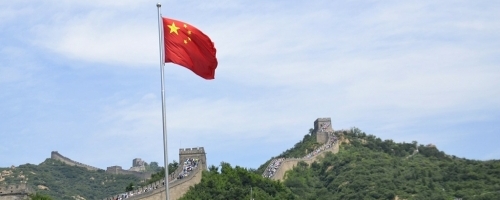Sign up to our newsletter Back to news
China’s military ambitions

China’s annual parliamentary meetings offer a glimpse into its future direction. This year, amidst economic headwinds, a key takeaway is the continued surge in defence spending.
China’s “two sessions”—a key conclave of the National People’s Congress and the Chinese People’s Political Consultative Conference—are an important political occasion to gauge its future direction. Even as the nation faces increasing headwinds with respect to its economy, for which the growth target in the coming year has been set at 5%, China’s outlay on national defence is set to increase by more than 7%.
This is the third consecutive year when China’s defence spending has increased by such a huge margin even as China’s actual military expenditure is much higher than the publicly stated figures. Last year, US Senator Dan Sullivan disclosed that Beijing’s spending on defence was close to $700 billion, which is around three time more than its official statistics. The rising defence expenditure is in line with President Xi Jinping’s ambition to build a world-class military by 2027, which is the centenary of the PLA.
"The Chinese military brass resolving to wage war on phony combat capabilities, which is being interpreted widely as a reference to graft within the ranks."
The parliamentary huddle is also an occasion when Xi as the supreme commander of the armed forces and head of the Central Military Commission, an apex body that oversees the People’s Liberation Army, recaliberates defence strategy. In his meeting with PLA delegates at the side-lines of the parliamentary session, Xi told his generals to overhaul PLA’s capabilities in the arena of cyberspace, space and artificial intelligence (AI), and to gear up for maritime conflicts. Amid this comes the Chinese military brass resolving to wage war on phony combat capabilities, which is being interpreted widely as a reference to graft within the ranks.
Corruption: Combatting the enemy within
In recent years, while the defence establishment has received a lion’s share, the funds may not have been utilised for the purposes intended. Chinese state media revealed “glaring shortcomings” in the Rocket Force units responsible for conventional and nuclear missiles. This was substantiated by an assessment of US intelligence agencies that graft within the PLA and its military-industrial establishment has blunted China’s defence preparedness, elaborating that missiles had been filled with water instead of fuel. Heads have rolled with several senior technocrats in the military industrial complex, and top military figures losing their seats in legislative and deliberative bodies. There has been a churn within the Communist Party of China’s (CPC) top leadership, with the disappearance of former defence minister Li Shangfu and former foreign minister Qin Gang from public view.
In recent times, there has been a heightened narrative on financial turpitude in China, with the PLA’s official newspaper recently warning soldiers and officers alike about the dangers of corruption. This was followed by an article in the CPC journal Qiushi in which Xi ordered auditors to scrutinise the working of top bureaucrats with a fine-tooth comb. The CMC has also weighed in on the issue, calling for PLA’s arms-acquisition and research units to concentrate on quality-control in order to fulfil Xi’s goal of defence modernisation.
Implications for external power projection
The increased allocation on defence and warnings of naval contestation assume significance in light of frequent forays by Chinese research vessels into the Indian Ocean, and China’s vociferous assertion of territorial claims along the Indian border, South China Sea, and with respect to Taiwan. The purge within the PLA and defence-industrial establishment has given rise to a sense of Schadenfreude, especially given that the tense standoff and massive troop build-up on the India-China border. However, the rejig indicates that by being tough on corruption, Xi is weeding out the black sheep, which has the potential to improve strategic capabilities in the long run.
"The purge within the PLA and defence-industrial establishment has given rise to a sense of Schadenfreude, especially given that the tense standoff and massive troop build-up on the India-China border."
Second, Xi’s exhortation to improve PLA’s capabilities in cyberspace and AI are a pointer to its nascent strategy. Xi established the Strategic Support Force (SSF) to spearhead warfare in cyber, electronic, and psychological ops as part of PLA’s modernisation, giving Beijing the ability to leverage its military prowess beyond its national borders. China’s internal discourse on modern warfare highlights both strengths and vulnerabilities. Strategists underscore building up comprehensive national strength to prepare for a protracted war, arguing that China needs to marshal its non-military factors like science and technology to build up strategic national capability. They prognosticate that that military threats will be reinforced with non-military elements and take the form of attacks on cyber assets, economic coercion, and non-state military groups. Indian policy-makers must be aware of Beijing’s designs in the cyberspace arena. This is borne out by the recent revelations of leaked documents from a hacking group, iSoon, with ties to the Chinese establishment that lifts the lid on systematic efforts to trawl data through cyber infiltrations. The Chinese company, which trawled the data is reported to have sold it to the Chinese government agencies. The targeted hacking campaigns have aimed at collecting data from Thailand, South Korea, the United Kingdom, Taiwan, and India. If data is the new oil, then for China, it is a new weapon in its arsenal. For example, China harvested data related to use of important motorways in Taiwan, which could give it an edge in the event of a future invasion, warn analysts. Thus, the rise of SSF in China’s strategic firmament, and the call to improve China’s strategic capabilities present India with new challenges.
Harsh V. Pant (V.P. ORF) and Kalpit A Mankikar (Strategic Studies Programme)
22 March 2024
Comments :
- No comments


Post a comment